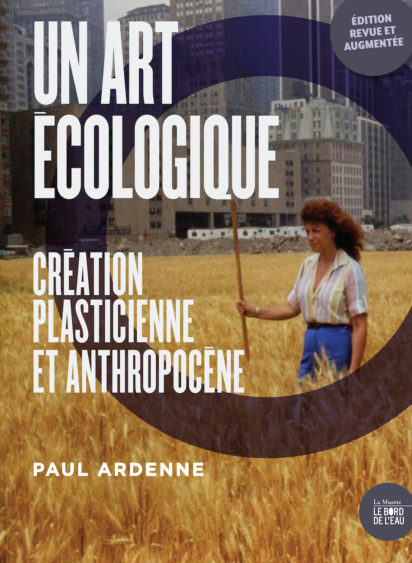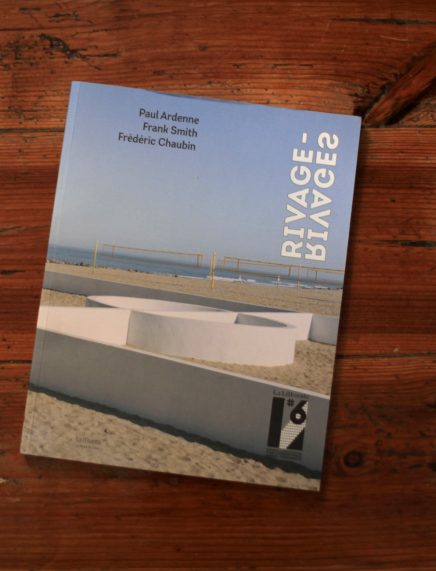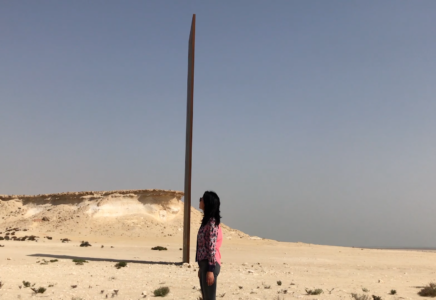Paul Ardenne’s new book
Un art écologique. Création plasticienne et anthropocène
Paul Ardenne’s book does not only offer a wealth of historical material on the artistic forms of the 02, it explores issues that have most certainly reached the mind of any visitor of a contemporary art exhibition, biennial or any other exhibition. Is “green” the new watchword of art? Can a leafy branch or a chunk of ice imported from the Arctic fully express our environmental concerns? In the current prolific artistic production that claims to be Ecological art, how can one separate the wheat from the chaff?
Paul Ardenne offers a few potential answers. According to him, an “eco-artwork” is “successful when the artwork, which cannot be embodied through traditional artistic forms, triggers within the audience a will to act, participate, clean up and help.” (p. 247) Indeed, Ecological art privileges forms that imply activist and concrete co-creations between artists and audience. It aims at being interactive and values responsibility while sharing the same ethics.
But prior to taking his stance, Ardenne goes back to the artistic sources of the 1970s when, in response to formal modernism, the question of nature emerged in an uproar, whether through the extension of landscaping concerns with Land art, or through the premises of Environmental art with artists such as Gina Pane. Moving out of the museums, but also into nature itself, stepping into the mud of marshes (Beuys), into a volcano (Turrell), going to the desert to install concrete cylinder (Holt) or to draw a spiral (Smithson), etc.: starting in the late 60s, numerous European and American artists choose to work within the landscape to find a new space for creation and to create works with nature, even to the risk of seeing them disappear or disintegrating. However, these works did not illustrate a particular concern. For the most part, they did not stem from any sort of environmental preoccupation, but merely turned to nature as a place for creation and production.
It was a very different story when artists started working with nature and “engage in a retaliation process” (p. 67) against destruction. It was first through contact, the friction between the body and the natural element (Mendieta, Long, Samnang, Laib), that artists gave evidence, in vivo, of their interaction with nature, whether through the creation of beeswax houses (Laib), or through something ephemeral, using a leaf or a tree branch (Goldsworthy). These actions highlight what is equitable; the artist only underlines and reveals a natural process that is usually concealed.
One of the most compelling chapters of the book is about Eden, or the vision of original and idyllic nature (that, for example, of Salgado in Genesis), to which is opposed an “anti-Eden”, because given the disastrous extent of ecocide, overestimating nature today would be lying, or even committing perjury (p. 110). Photo reporters working for magazines (Life) or agencies (Magnum) during the first major oil spills or the Vietnam War were the first to unveil the disaster. Now that we cannot ignore the chaos of the Anthropocene, how can we clearly show it? In the 2015 exhibition Exit, philosopher and urbanist Paul Virilio managed to give a non-repulsive image of the “anti-Eden”, for in art images have a power of seduction and repulsion. Did he turn the disaster into a great spectacle? Probably, but between the Eden of entertainment and the anti-Eden of total disintegration of the Earth-system, “we are waiting to see which of the two will triumph, and the spectacle goes on.” (p. 115)
Homo sapiens are also homo demens: they destroy what they patiently built. For example, they go to magnificent landscapes that they find awe-inspiring but litter them with trash, as shown in Wolfgang Niedermayr’s photographs. Australian environmental philosopher Glenn Albrecht invented the term “solastagia” to refer to the nostalgia humans feel for a comforting place. In the same line are presented works that deplore the lack of solid places humans can hold on to. We have lost our house or are about to: Marie Velardi’s vanishing islands punctuate the book (Atlas des îles perdues – Atlas of Lost Islands) and powerfully make us ponder on the moment when inhabited land will flood and change configuration.
It is now time to reach further and operate not only with nature, but also for nature: activism is at the top of the hierarchy of Ecological art. Participation of the audience, mobilization for causes, unveiling of scandals: it goes without saying that “involved and militant forms of creation inspire awareness and concrete action.” (p. 249) But this call for participation takes us back to artworks from the end of the 1960s such as the “Maintenance Art” of Mierle Laderman Ukeles, who advocated the act of cleaning up as an involved artistic form, or such as Agnes Denes’ remarkable 1982 creation, when she planted wheat fields in South Manhattan (cover picture). Paul Ardenne’s book places these fundamental gestures back into a history that relates them to contemporary philosophical concepts, and this is one of the book’s great merits.
Ethics have therefore become “the new fuel for environmental art creation”, which Ardenne refers to as “anthropocènart”, a neologism close to what Nathalie Blanc named “écoplastie” (p. 259-263), an art that is undergoing a deep renewal to which, according to the author, we are little prepared. Thankfully, this book helps considerably.


